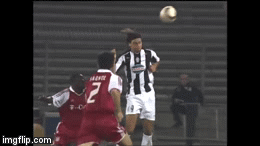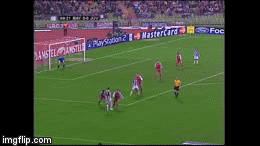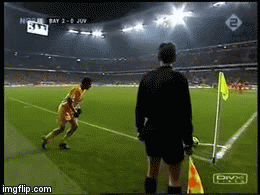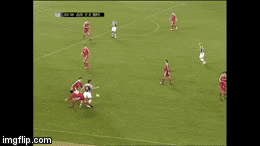AC Milan’s then coach, Fabio Capello, did not exactly welcome Savicevic with open arms, viewing him as one of Berlusconi’s extravagant signings. Coupled with the three foreigner rule (only three non-Italian’s were permitted per match squad), Savicevic found playing time sparse. It is unsurprising given he was competing with the likes of Dutch trio, Ruud Gullit, Frank Rijkaard and Marco Van Basten, as well as Frenchman, Jean Pierre Papin and Croatian Zvomir Boban.
As a result, Savicevic only graced the pitch ten times during his debut season and didn’t score until the end of January, his first of only four goals all campaign. Milan won the Scudetto for a second consecutive season and made it to the Champions League final, losing 1-0 to French club Marseille.
Symptomatic of his first season in Milan, the Montenegrin didn’t even find his way into the squad and looked set to leave the club after a tough start to life in Italy.
Things changed for the better during the following season for a number of reasons. Firstly, despite Capello’s wish to offload the expansive midfielder, Berlusconi was adamant that the creative flair of Savicevic should not only stay at the club, but also be given more playing time. Competition for one of the three foreign player berths was also made easier. Van Basten was in the process of having a year’s sabbatical to recover from his ankle injury (alas a futile attempt as this injury proved career ending) while Gullit and Rijkaard left to Sampdoria and Ajax respectively. Thus Savicevic, Boban, and Papin became the only foreigners in the squad for the first part of the season.
Preseason started well with Savicevic a regular. But it was not long before Capello started to show his lack of confidence in the Montenegrin, repeatedly substituting him for Italian international Roberto Donadoni. It was only a matter of time before he lost his starting place to the Italian. After not appearing for five league games, the highly strung midfielder made his feelings known via the Italian media and eventually confronted his coach to try and rectify the increasingly frustrating situation.
A heated showdown with some course language followed, but this seemed to have the desired effect and the man from Titograd finally got some playing time. Although, in true Capello style, the veteran coach ensured the midfielder knew who was boss by leaving him out of the squad for both the Derby Della Madonnina (Milan Derby) and the Juventus clash.
Starts were sporadic and tensions rose again after Savicevic was dropped to the bench for the Champions League match against Anderlecht, and he was out of the squad completely for the Intercontinental game against Brazilian side Sao Paulo.
The former Red Star man demonstrated his fiery temperament again, refusing to take his place among the substitutes against Anderlecht and then questioning Capello’s tactics through the Italian newspapers.
The questioning of Milan’s tactics compared to the previous two season’s was perhaps justified. The last two campaigns had produced title winning sides playing a more expansive style of play. Defensive duties were important, but there was more of an attacking emphasis and Milan had scored 65 and 75 goals in an 18 team division, with goal differences of +33 and +53 respectively.
Under the new defensive style, the creative play of Savicevic was shackled and the “work, work, work” ethic of constant and incessant pressing was not to Dejan’s liking. It was only his friendship with Berlusconi that persuaded the Montenegrin to stay in Milan. This friendship did bear fruit however, and in the second half of the season, Savicevic secured a regular starting place.
Milan won a third straight Scudetto but the creative flair had been curtailed by the conservatism of Capello’s new tactics. Savicevic suffered as he failed to score in the domestic season. But he was not the only one, with striker Papin saying “If Capello's system looks boring from the stands, it's even worse to play in.” The impact of those tactics was such that, the following season, the Italian Football Association implemented the three points for a win system in hope of eradicating such ‘tedious’ Calcio.
While Savicevic struggled domestically, he excelled on the European scene. Despite watching most Champions League games from the sidelines prior to the winter break, his recall to the side for the semi-final against French Champions Monaco inspired the
Rossoneri to a 3-0 victory. This set up a final against the “Dream Team” of Johan Cryuff’s Barcelona.
Nobody gave Milan a chance and Capello’s strategy had been dismantled with the injuries and suspensions. First choice centre back’s Franco Baresi and Alessandro Costacurta were both suspended, midfielder
Gianluigi Lentini was still recovering from a horrific car crash and striker Jean Pierre Papin also missed the final through injury, replaced by veteran striker Daniele Massaro. Capello changed not only his formation but his mindset and decided to take the game to Barcelona. This suited Savicevic perfectly. Gone was the rigid 4-4-2, replaced by a more flexible 4-1-4-1 system, with Marcel Desially sitting in front of an inexperienced defence containing Paolo Maldini and Christian Panucci.
Savicevic was inspiring and his performance is renowned as one of the best in a European Cup Final. Broken free from his defensive shackles, he ran the game showing why Berlusconi was right to keep him at the club. He created the
Diavolo’s first goal, playing a perfect through ball for Massaro in the 27th minute. He was also involved Milan’s second, after a 16 pass move was finished off by Massaro once again.
But Savicevic’s true moment of genius was yet to come. Just after half time, Savicevic raced down the right to close down Miguel Angel Nadal. Dispossessing the Spanish international defender, he then noticed Andoni Zubizarreta off his line and, from just outside the box, clipped an audacious and perfectly weighted lob over Zubizaretta into the net. It was one of the great
European Cup goals and undoubtedly the Montenegrin’s magnum opus. To cap it all off, he was involved in the fourth and final goal, as his shot hit the post, allowing Desailly to finish the rebound. Savicevic had played the game of his life and inspired Milan to a famous 4-0 victory.
Unfortunately for the playmaker, the season after Capello reverted back to type and Milan struggled, finishing fourth in Serie A and losing in the Intercontinental cup final. D
espite his injury travails, Savicevic still scored nine goals in 19 appearances, including four in one
game against Bari at the Stadio San Nicola, the ground where he won the European Cup with Red Star Belgrade.
The
1995-96 campaign was to be Savicevic’s most productive in a Milan shirt. Capello bowed to pressure and played a more expansive style of football and this saw the Yugoslav international make 23 Serie A appearances, scoring six goals in the process. He endeared himself to the Milan faithful further after scoring against city rivals Inter in the Derby Della Madonnina, while a memorable performance against Parma highlighted all his skills and technical ability. He left Parma defenders Fernando Couto and Luigi Apolloni in his wake before laying the ball to Roberto Baggio to score and later added a goal of his own. The Rossoneri claimed their fifteenth Scudetto, finishing eight points above Juventus.
Over the next two seasons, the Montenegrin’s playing time gradually diminished and he would eventually leave the club for an ill-fated return to Red Star Belgrade. He finished his career at Rapid Vienna, happy in his free role and devoid of any defensive responsibilities.
 vs
vs

















